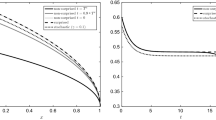Abstract
We consider a noncooperative differential game where a retailer sells her own private label in addition to the manufacturer’s brand. We assume that each brand’s goodwill evolves according to a modified Nerlove-Arrow dynamics, in such a way that the advertising effort of one brand hurts the competitor’s goodwill stock. We characterize Feedback-Stackelberg pricing and advertising strategies and employ simulations to analyze their sensitivity to the main model parameters.
Similar content being viewed by others
References
Ailawadi, K. L., Kopalle, P. K., & Neslin, S. A. (2005). Predicting competitive response to a major policy change: Combining game-theoretic and empirical analysis. Marketing Science, 24(1), 12–24.
Amrouche, N., Martín-Herrán, G., & Zaccour, G. (2007). Pricing and advertising of private and national brands in a dynamic marketing channel (Working Paper).
Anderson, E., Coughlan, A. T., El-Ansary, A., & Stern, L. W. (2001). Marketing channels (6th edn.). New York: Prentice Hall.
Breton, M., Chauny, F., & Zaccour, G. (1997). A leader-follower dynamic game of new product diffusion. Journal of Optimization Theory and Applications, 92(1), 77–98.
Breton, M., Jarrar, R., & Zaccour, G. (2006). A note on feedback Stackelberg equilibria in a Lanchester model with empirical application. Management Science, 52(5), 804–811.
Chakrabarti, S., & Haller, H. (2004). An analysis of advertising wars (Working paper). Virginia Polytechnic Institute, USA.
Chintagunta, P. K., & Jain, D. (1992). A dynamic model of channel member strategies for marketing expenditures. Marketing Science, 11(2), 168–188.
Choi, S. C., & Coughlan, A. T. (2006). Private label positioning: Quality versus feature differentiation from the national brand. Journal of Retailing, 82(2), 79–93.
Cotterill, R. W., & Putsis, Jr., W. P. (2001). Do models of vertical strategic interaction for national and store brands meet the market test? Journal of Retailing, 77, 83–109.
Deal, K. R. (1979). Optimizing advertising expenditures in a dynamic duopoly. Operations Research, 27(4), 682–692.
Dockner, E., Jørgensen, S., Van Long, N., & Sorger, G. (2000). Differential games in economics and management science. Cambridge University Press: Cambridge.
Erickson, G. M. (1991). Dynamic models of advertising competition. Kluwer Academic: Dordrecht.
Espinosa, M., & Mariel, P. (2001). A model of optimal advertising expenditures in a dynamic duopoly. Atlantic Economic Journal, 29(2), 135–161.
Hoch, S. J., & Banerji, S. (1993). When do private labels succeed? Sloan Management Review, 34, 57–67.
Jørgensen, S., & Zaccour, G. (1999). Equilibrium pricing and advertising strategies in a marketing channel. Journal of Optimization Theory and Applications, 102(1), 111–125.
Jørgensen, S., & Zaccour, G. (2003). A differential game of retailer promotions. Automatica, 39(7), 1145–1155.
Jørgensen, S., Sigué, S. P., & Zaccour, G. (2000). Dynamic cooperative advertising in a channel. Journal of Retailing, 76(1), 71–92.
Jørgensen, S., Sigué, S. P., & Zaccour, G. (2001a). Stackelberg leadership in a marketing channel. International Game Theory Review, 3(1), 13–26.
Jørgensen, S., Taboubi, S., & Zaccour, G. (2001b). Cooperative advertising in a marketing channel. Journal of Optimization Theory and Applications, 110(1), 145–158.
Jørgensen, S., Taboubi, S., & Zaccour, G. (2003). Retail promotions with negative brand image effects: Is cooperation possible? European Journal of Operational Research, 150(2), 395–405.
Karray, S., & Zaccour, G. (2006). Could co-op advertising be a manufacturer’s counter strategy to store brands? Journal of Business Research, 59, 1008–1015.
Martín-Herrán, G., & Taboubi, S. (2005). Shelf-space allocation and advertising decisions in the marketing channel: A differential game approach. International Game Theory Review, 7(3), 1–18.
Martín-Herrán, G., Taboubi, S., & Zaccour, G. (2005). A time-consistent open-loop Stackelberg equilibrium of shelf-space allocation. Automatica, 41(6), 971–982.
Nair, A., & Narasimhan, R. (2006). Dynamics of competing with quality and advertising based goodwill. European Journal of Operational Research, 175, 462–474.
Nerlove, M., & Arrow, L. (1962). Optimal advertising policy under dynamic considerations. Economica, 29(114), 129–142.
Raju, J. S., Sethuraman, R., & Dhar, S. K. (1995). The introduction and performance of store brands. Management Science, 41(6), 957–978.
Roberts, M. J., & Samuelson, L. (1988). An empirical analysis of dynamic nonprice competition in an oligopolistic industry. RAND Journal of Economics, 19(2), 200–220.
Sayman, S., & Raju, J. S. (2004). How category characteristics affect the number of store brands offered by the retailer: A model and empirical analysis. Journal of Retailing, 41(6), 957–978.
Sayman, S., Hoch, S. J., & Raju, J. S. (2002). Positioning of store brands. Marketing Science, 21(4), 378–397.
Wilensky, D. (1994). Private label success no secret as discount. Discount Store News, 33(5), 23–44.
Author information
Authors and Affiliations
Corresponding author
Additional information
We thank an anonymous Reviewer for very helpful comments. Research supported by NSERC, Canada, and FQRSC, Quebec. Research completed when the second author was a visiting professor at GERAD, HEC Montréal. The second author’s research was partially supported by MEC and JCYL under projects SEJ2005-03858/ECON and VA045A06, co-financed by FEDER funds.
Rights and permissions
About this article
Cite this article
Amrouche, N., Martín-Herrán, G. & Zaccour, G. Feedback Stackelberg equilibrium strategies when the private label competes with the national brand. Ann Oper Res 164, 79–95 (2008). https://doi.org/10.1007/s10479-008-0320-7
Received:
Accepted:
Published:
Issue Date:
DOI: https://doi.org/10.1007/s10479-008-0320-7




